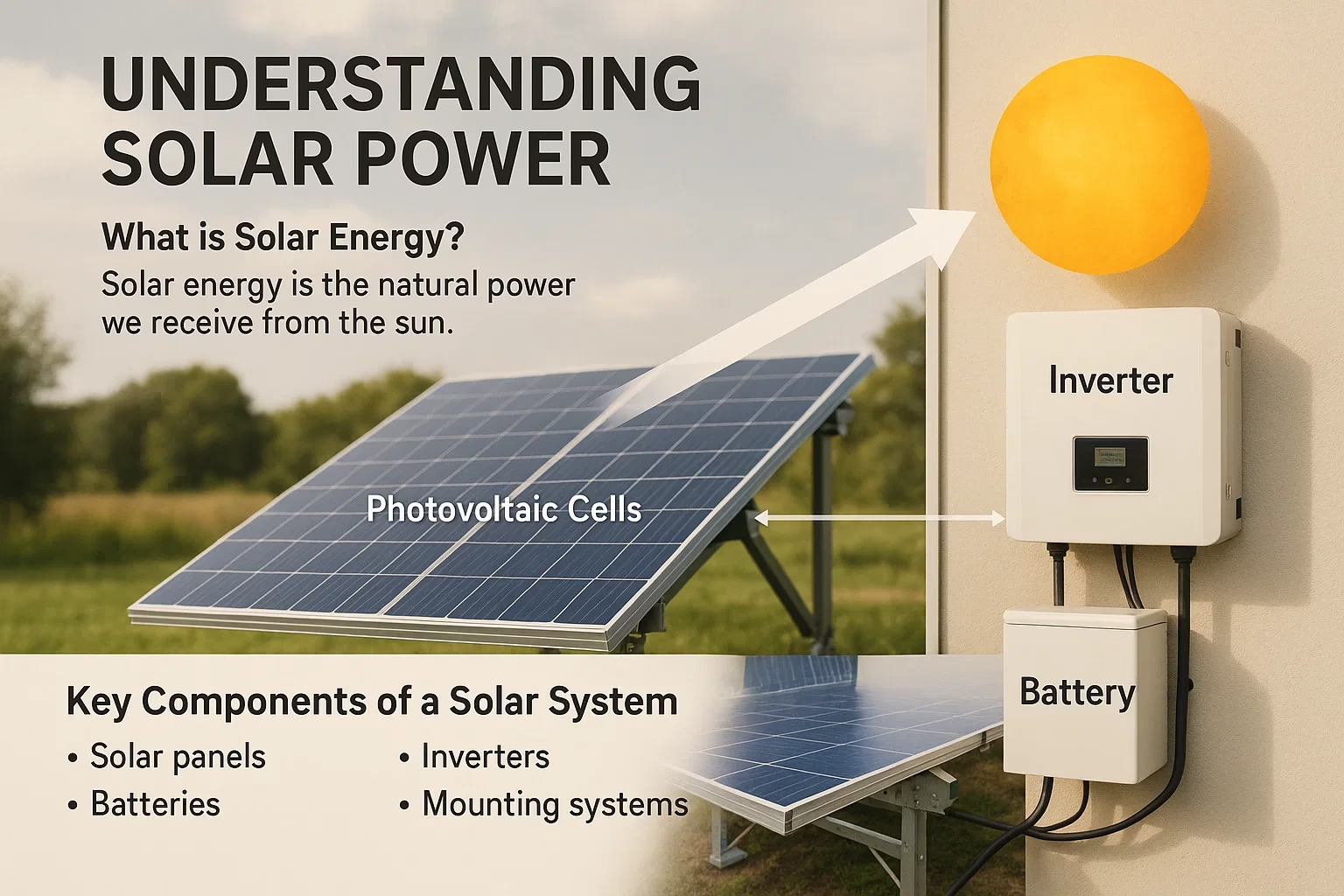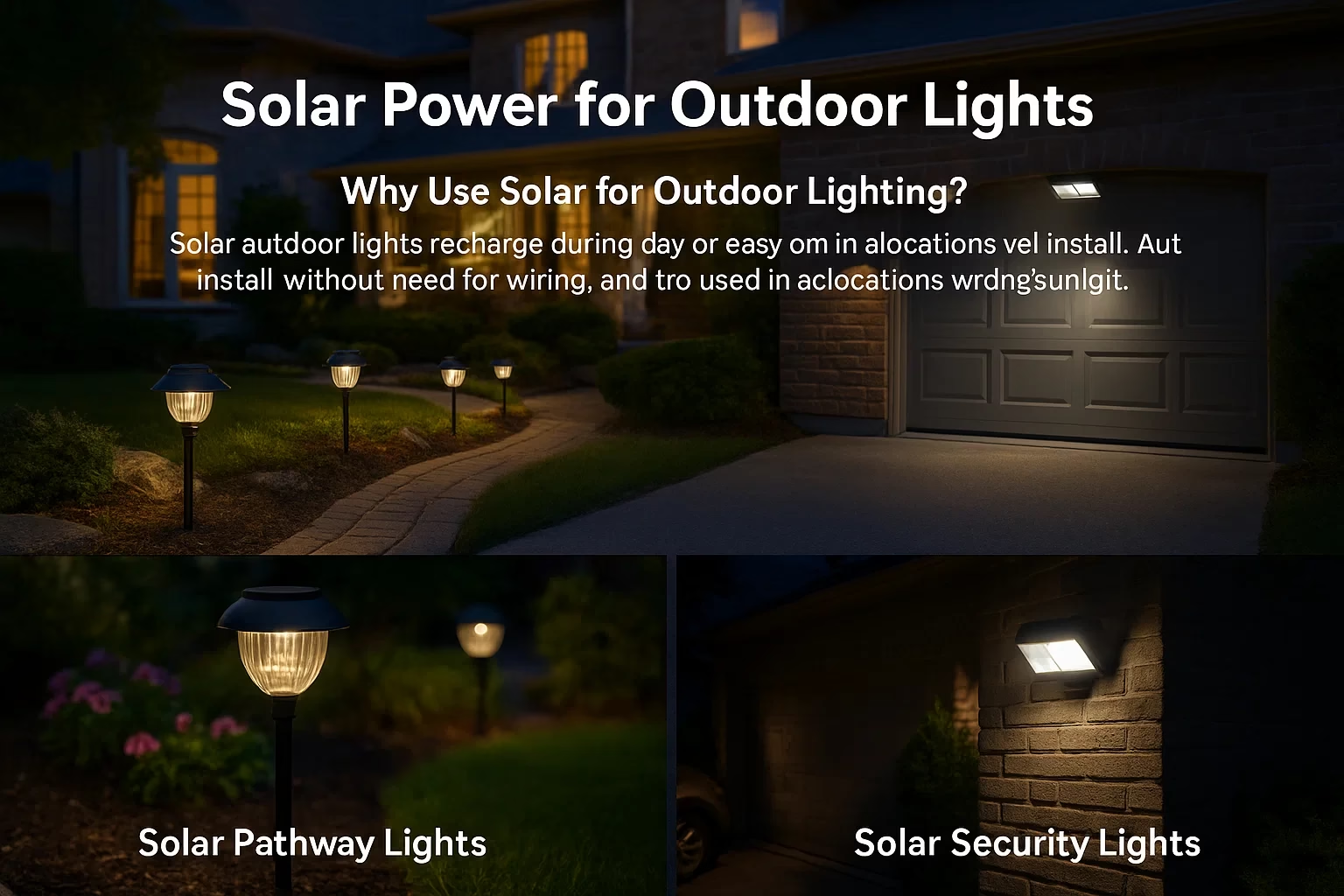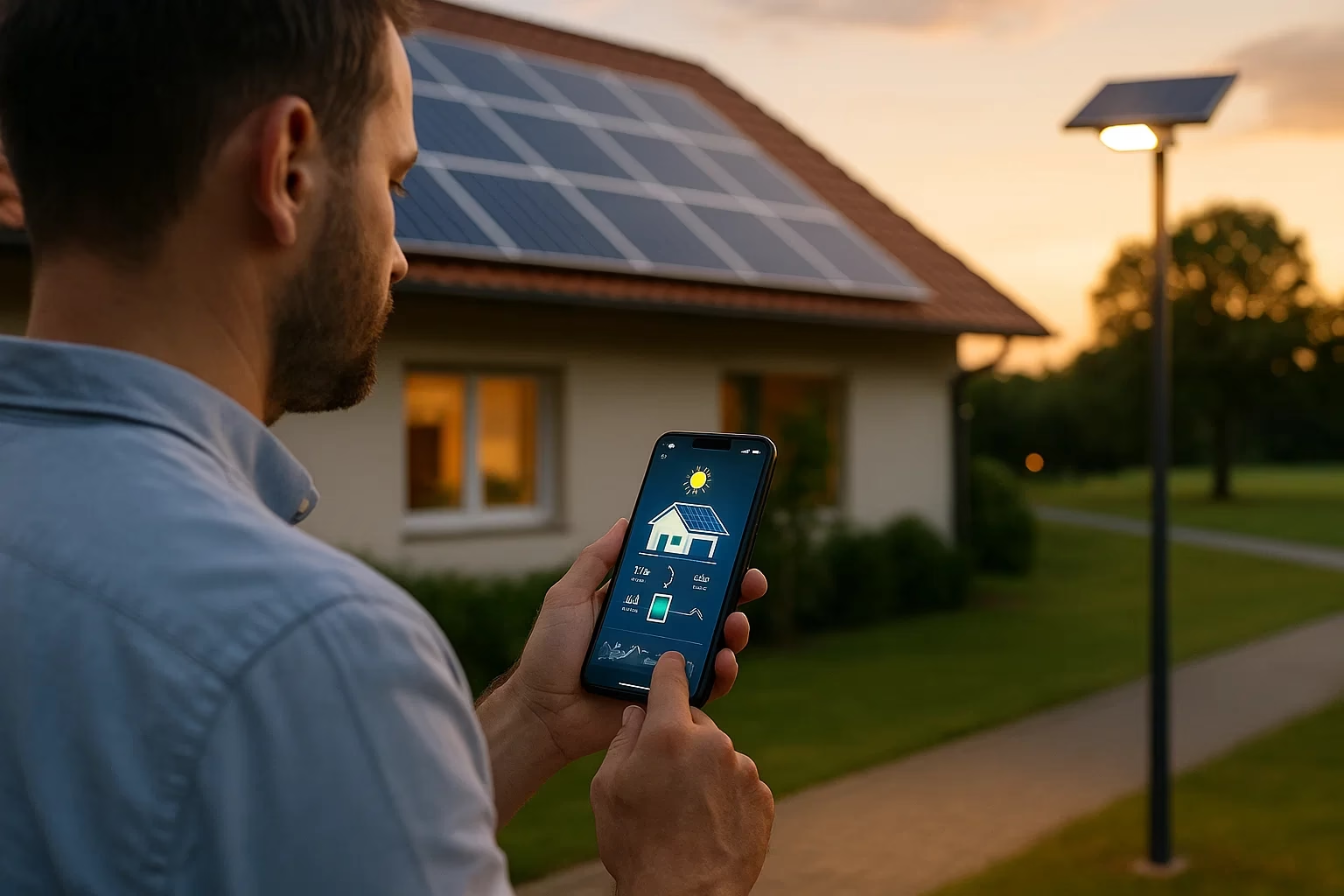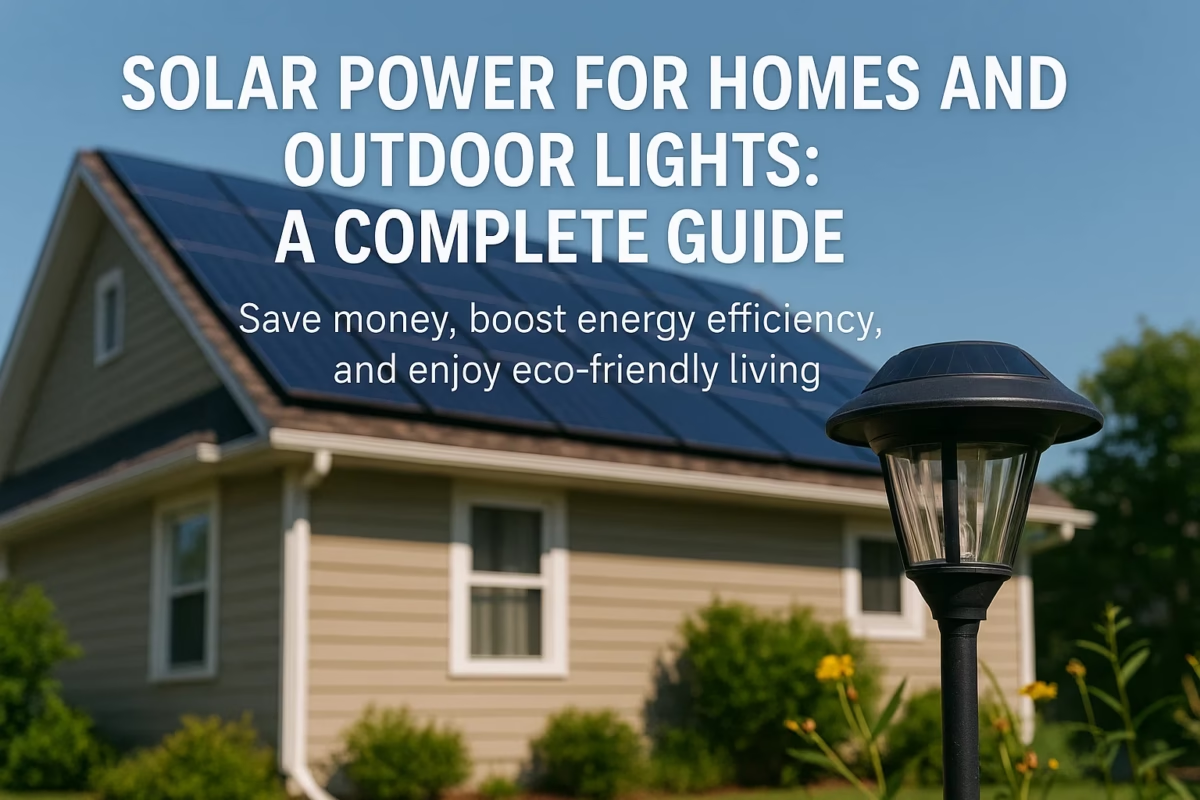Real Estate, Engineering
Solar Power for Homes and Outdoor Lights: A Complete Guide
Have you noticed how more and more people are turning to solar energy these days? It is not just a passing trend. It is a shift in how we think about power and sustainability. The idea of using sunlight to run your home or light up your garden might have sounded futuristic a few years ago, but today it is practical, affordable, and increasingly popular.
Solar power for homes is helping families cut down on electricity costs and gain more independence from the grid. At the same time, solar power for outdoor lights is giving homeowners an easy and stylish way to brighten their yards without worrying about higher energy bills. Both options are part of a growing movement toward greener living and smarter energy choices.
Think of it this way: every morning the sun rises and pours out free energy. All you need are the right tools to capture it. Whether you are looking to power an entire household or simply add charming lights to your walkway, solar technology makes it possible. This guide will walk you through the essentials, benefits, challenges, and future of using solar energy for homes and outdoor lighting.
Understanding Solar Power
Before we dive deeper into the benefits and installation, it is important to understand how solar power actually works. At its core, solar energy is about turning the sun’s rays into electricity that we can use in our everyday lives. The process may sound complicated, but once you break it down it is quite simple and fascinating.

What is Solar Energy?
Solar energy is the natural power we receive from the sun. Unlike fossil fuels, which take millions of years to form and release harmful emissions, solar energy is clean, renewable, and available every single day. It is a resource that never runs out and one that is becoming increasingly important as people look for ways to reduce their carbon footprint and save on energy costs.
How Solar Panels Work
Imagine solar panels as giant sponges for sunlight. These panels are made of photovoltaic cells that capture sunlight and convert it into direct current electricity. Since most homes run on alternating current, an inverter is used to change the electricity into a form that powers household appliances, from light bulbs to refrigerators. Even on cloudy days, solar panels can still generate electricity, though at a lower level.
Key Components of a Solar System
A complete solar power setup for a home or outdoor use has several important parts working together.
Solar panels: These capture the sunlight and start the process of energy conversion.
Inverters: These devices transform the electricity from direct current into alternating current so it can be used in the home.
Batteries: These store excess energy for use at night or during times when the sun is not shining.
Mounting systems: These provide support and keep the panels securely in place on roofs or on the ground.
When all these components are combined, they create a reliable and sustainable energy system that can power everything from an entire household to simple outdoor garden lights. Solar energy is not just about technology. It is about using nature’s most abundant resource in a smarter and cleaner way.
Benefits of Solar Power for Homes
Switching to solar power for homes comes with a variety of advantages that go far beyond just saving money. Homeowners who invest in solar technology often find that the benefits touch nearly every aspect of their daily lives, from finances to lifestyle and even long-term property value.
Cost Savings on Electricity Bills
One of the most obvious and appealing benefits of solar energy is the reduction in monthly electricity bills. By generating your own electricity, you rely less on your local utility company. Over time, this adds up to significant savings. Some households are even able to eliminate their electricity bills entirely, depending on the size of their system and their energy usage. Imagine redirecting that saved money into family activities, home upgrades, or long-term investments instead of paying it to the power company.
Energy Independence
Relying completely on the grid leaves you vulnerable to rising electricity prices and unexpected outages. Solar power gives you more control. By producing your own energy, you become less dependent on outside sources. This independence means greater stability for your household. With the addition of batteries, you can even store excess energy for use at night or during blackouts, keeping your home running smoothly regardless of what happens on the grid.
Eco-Friendly Living
Choosing solar energy is also a commitment to protecting the environment. Unlike fossil fuels, solar power does not release harmful greenhouse gases or pollutants into the atmosphere. By installing solar panels, you are directly reducing your carbon footprint and contributing to cleaner air and a healthier planet. For families who care about leaving a better world for future generations, this is one of the most rewarding benefits.
Increase in Property Value
Solar power systems are more than just an energy solution; they are an investment in your home. Studies show that homes equipped with solar panels tend to sell faster and at higher prices than those without. Buyers are increasingly attracted to properties with built-in energy savings and eco-friendly features. Installing solar not only benefits you while you live in the home but can also pay off when it comes time to sell.
Solar power for homes is not just about short-term savings. It is a lifestyle upgrade that promotes financial freedom, environmental responsibility, and long-term value. It is no wonder so many homeowners are making the switch to solar energy.
Installing Solar Power for Homes
Making the decision to install solar power for homes is an exciting step toward energy independence and sustainable living. However, it is important to understand the different options, equipment, and financial incentives available before getting started. A well-planned installation ensures that your solar system performs efficiently and meets your household’s energy needs for many years.
Roof Mounted vs Ground Mounted Systems
When it comes to installing solar panels, you have two main choices for placement. Roof mounted systems are the most common. They take advantage of unused roof space and do not require additional land. This option is ideal for homes with roofs that receive plenty of direct sunlight and have enough surface area to hold the necessary number of panels.
Ground mounted systems, on the other hand, are installed on open land near the home. These are perfect for households with large yards or properties where the roof is shaded or structurally unsuitable. Ground systems are easier to access for cleaning and maintenance, and they can be angled perfectly toward the sun to maximize efficiency. The tradeoff is that they require extra space in your yard.
Choosing the Right Solar Panel Type
Not all solar panels are the same. Each type has its own benefits depending on your budget and energy goals.
Monocrystalline panels are highly efficient and long lasting. They are a good option for homeowners who want maximum performance but are willing to pay a higher price.
Polycrystalline panels are more affordable and still provide solid efficiency, making them a popular choice for budget conscious homeowners.
Thin film panels are lightweight and flexible, which makes them easier to install in unique spaces. However, they are generally less efficient and less durable than other types.
Selecting the right type of panel often comes down to balancing cost, efficiency, and available space.
The Role of Inverters and Batteries
While panels capture sunlight, inverters are what make that energy usable in your home. An inverter converts the electricity from direct current into alternating current so that it can power appliances, electronics, and lighting. Without an inverter, the system would not work for your household.
Batteries add even more value to a solar setup. They store extra electricity generated during the day so you can use it at night or during a power outage. For families who want greater independence from the grid, batteries are a worthwhile addition to the system.
Government Incentives and Rebates
One of the best things about installing solar today is that many governments and local authorities offer financial incentives to make it more affordable. These incentives can come in the form of tax credits, rebates, or low interest financing programs. In some regions, you can even sell excess electricity back to the grid and earn money through net metering programs.
Taking advantage of these programs can significantly reduce the upfront cost of installation and shorten the time it takes for your system to pay for itself through savings on energy bills.
Installing solar power for homes is not just about choosing panels and putting them in place. It is about making smart choices that suit your lifestyle, budget, and energy needs. With the right setup, you can enjoy decades of reliable, clean, and cost effective power straight from the sun.
Solar Power for Outdoor Lights
Outdoor lighting has come a long way in recent years, and solar power has completely transformed the way we light up our yards, gardens, and driveways. Solar power for outdoor lights offers a convenient, eco-friendly, and cost-effective solution that eliminates the need for wiring, reduces electricity bills, and provides reliable illumination wherever you need it. Whether you are looking for security, decoration, or simple pathway lighting, solar-powered options have you covered.

Why Use Solar for Outdoor Lighting?
The biggest advantage of solar outdoor lights is their independence from the electrical grid. Instead of running cables across your property or worrying about higher energy consumption, these lights rely on the sun to recharge their batteries during the day. At night, the stored energy powers the lights, giving you consistent illumination without ongoing costs.
They are also extremely easy to install. There is no need for professional wiring or complicated setups. Simply place them in a location with adequate sunlight, and they will begin working. This makes solar lights an affordable and practical choice for any homeowner.
Types of Solar Outdoor Lights
Solar Pathway Lights
Pathway lights are designed to illuminate walkways, driveways, or garden paths. They not only improve safety by preventing trips and falls but also add a warm and welcoming touch to your home’s exterior.
Solar Floodlights
Floodlights provide bright, wide coverage, making them ideal for large outdoor areas such as backyards, driveways, or patios. These lights often come with motion sensors, ensuring they only turn on when needed, which helps conserve stored energy.
Solar Garden Lights
Garden lights are smaller and more decorative. They are perfect for highlighting flower beds, shrubs, or landscaping features. They bring beauty and charm to outdoor spaces, making evenings more enjoyable.
Solar Security Lights
Security lights powered by solar are an excellent way to enhance safety around your home. These lights usually feature motion detection, automatically switching on when movement is detected. They help deter intruders while still being cost-effective and energy-efficient.
Installation Tips for Outdoor Solar Lights
To get the best performance from solar outdoor lights, placement is key. Always install them in areas that receive direct sunlight for most of the day. Avoid locations shaded by trees, fences, or buildings, as this will reduce their ability to recharge.
Keep the solar panels clean by wiping away dust and debris regularly. This ensures maximum sunlight absorption and better performance. For motion sensor lights, position them strategically so they cover entryways, garages, or areas where movement is most likely.
Solar power for outdoor lights is one of the simplest and most rewarding ways to use renewable energy around your home. With easy installation, virtually no maintenance, and long-term savings, it is an investment that adds beauty, security, and sustainability to your outdoor living spaces.
Challenges of Solar Power
While solar energy offers countless benefits, it is important to recognize that it is not without challenges. Understanding these limitations helps homeowners make informed decisions and set realistic expectations before investing in a solar system.
Initial Installation Cost
One of the most common concerns about solar power is the upfront cost. The price of purchasing panels, inverters, batteries, and installation services can be significant. Even though costs have decreased over the years, many homeowners still find the initial expense intimidating. However, it is worth remembering that solar is a long-term investment. Over time, the money saved on electricity bills can outweigh the upfront price, especially when government rebates or financing options are available.
Space Requirements
Not every home or property is ideally suited for solar installation. Roofs that are too small, too shaded, or oriented away from direct sunlight may not provide enough space or efficiency for the system to generate sufficient power. Ground mounted systems require extra land, which is not always available in urban or small residential areas. This limitation can be a challenge for homeowners who want solar but lack the necessary space.
Efficiency Limits
Solar panels perform best in regions with plenty of sunshine. While they do generate electricity on cloudy or rainy days, their efficiency drops significantly in low light conditions. Seasonal changes can also affect how much power is produced. For example, long winter nights may reduce the available time for panels to recharge. Advances in technology are improving efficiency every year, but for now, weather and geography still play an important role in solar performance.
Despite these challenges, solar energy remains one of the most promising and sustainable power sources available. With careful planning, proper installation, and a clear understanding of its limitations, solar power can still provide reliable and cost effective energy for many households.
The Future of Solar Power for Homes and Outdoor Lights
The world of solar energy is constantly evolving, and the future looks brighter than ever. As technology advances, solar power is becoming more efficient, more affordable, and more accessible to homeowners everywhere. The way we use solar energy today is just the beginning. In the coming years, we can expect even smarter systems, better integration with our daily lives, and a stronger role in building sustainable communities.

Smart Solar Technology
One of the most exciting developments in solar energy is the rise of smart technology. Modern solar systems are no longer limited to just panels and inverters. Many now include smart monitoring tools that allow homeowners to track energy production and consumption in real time through mobile apps. This means you can see exactly how much electricity your panels are generating, when your batteries are charging, and how much power you are using at any moment. Smart technology also enables systems to adjust automatically for maximum efficiency, giving you the most value from your solar setup.
Integration with Smart Homes
The future of solar power is closely connected with the future of smart homes. Imagine controlling your solar-powered lights, appliances, and heating systems with a simple voice command or through your smartphone. This kind of integration is already becoming a reality. Solar outdoor lights, for example, can be connected to smart home systems, allowing you to schedule when they turn on or dim them for different moods. Combining solar energy with home automation creates a lifestyle that is not only convenient but also energy conscious.
The Role of Solar in Sustainable Living
As concerns about climate change grow, solar power is expected to play an even larger role in building sustainable lifestyles. Communities around the world are embracing solar not just for individual homes but also for shared spaces, public lighting, and entire neighborhoods. Outdoor solar lighting in public parks, streets, and community centers reduces the demand on city power grids and lowers overall emissions. For individual homeowners, solar energy offers a way to live more responsibly while still enjoying modern comforts.
The future of solar power for homes and outdoor lights is filled with possibilities. With advancements in technology, greater affordability, and a stronger push toward eco-friendly living, solar energy is set to become an essential part of everyday life. It promises not only lower bills and greater independence but also a cleaner and more sustainable world for generations to come.
Conclusion
Solar power is no longer an alternative option reserved for the future. It is here right now, transforming the way families live and how communities grow. From reducing electricity bills to providing clean energy for homes and outdoor spaces, solar power is a practical solution that combines savings, convenience, and environmental responsibility. Whether you want to power your entire household or simply add beautiful lighting to your garden, solar energy opens the door to a more sustainable lifestyle.
The choice to switch to solar is more than just a financial decision. It is also a commitment to independence, innovation, and greener living. Every panel installed and every solar outdoor light placed in your yard is a step toward a brighter, cleaner, and more energy conscious future.
If you are planning to build or design your dream home, this is the perfect time to think about how solar power can be part of that vision. A well designed house plan makes all the difference in how effectively solar systems can be integrated. This is where Nyolenju Structures comes in. With expertise in designing functional, stylish, and energy efficient house plans, Nyolenju Structures can help you create a home that is not only beautiful but also ready for solar power.
Take the first step toward sustainable living by exploring smart home designs that embrace solar energy from the ground up. Reach out to Nyolenju Structures today and let them help you design a home that matches your lifestyle, saves you money, and supports a cleaner planet. The sun is already shining. All you need is the right plan to capture its power.
FAQs
1. How long do solar panels last?
Most panels last 25–30 years with proper care.
2. Can solar outdoor lights work in winter?
Yes, though they may shine dimmer due to reduced sunlight.
3. Do solar panels increase home insurance costs?
Not always. Some insurers even offer discounts for eco-friendly upgrades.
4. How many solar panels are needed to power a home?
It depends on your energy use, but typically 15–25 panels for average households.
5. Are solar outdoor lights worth it?
Absolutely! They’re affordable, easy to install, and save electricity costs.

